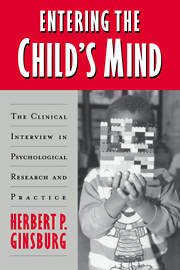Crossref Citations
This Book has been
cited by the following publications. This list is generated based on data provided by Crossref.
Zazkis, Rina
1999.
Intuitive rules in number theory: Example of ‘The more of A, the more of B’ rule implementation.
Educational Studies in Mathematics,
Vol. 40,
Issue. 2,
p.
197.
Hung, David Wei Loong
1999.
Activity, apprenticeship, and epistemological appropriation: Implications from the writings of...
Educational Psychologist,
Vol. 34,
Issue. 4,
p.
193.
Heng, Mary Anne
2000.
Scrutinizing Common Sense: The Role of Practical Intelligence in Intellectual Giftedness.
Gifted Child Quarterly,
Vol. 44,
Issue. 3,
p.
171.
Kirshner, David
2001.
Book Review: Entering the Child's Mind: The Clinical Interview in Psychological Research and Practice.
Mind, Culture, and Activity,
Vol. 8,
Issue. 2,
p.
205.
Gutieérrez-Clellen, Vera F.
and
Penña, Elizabeth
2001.
Dynamic Assessment of Diverse Children.
Language, Speech, and Hearing Services in Schools,
Vol. 32,
Issue. 4,
p.
212.
Kahn, Peter H.
and
Lourenço, Orlando
2002.
Water, Air, Fire, and Earth.
Environment and Behavior,
Vol. 34,
Issue. 4,
p.
405.
Fried, Michael N.
and
Amit, Miriam
2003.
Some reflections on mathematics classroom notebooks and their relationship to the public and private nature of student practices.
Educational Studies in Mathematics,
Vol. 53,
Issue. 2,
p.
91.
Yau, Jenny
and
Smetana, Judith
2003.
Adolescent-Parent conflict in Hong Kong and Shenzhen: A comparison of youth in two cultural contexts.
International Journal of Behavioral Development,
Vol. 27,
Issue. 3,
p.
201.
Pappas, Sandra
Ginsburg, Herbert P
and
Jiang, Minyang
2003.
SES differences in young children’s metacognition in the context of mathematical problem solving.
Cognitive Development,
Vol. 18,
Issue. 3,
p.
431.
Peña, Elizabeth
Bedore, Lisa M.
and
Rappazzo, Christina
2003.
Comparison of Spanish, English, and Bilingual Children’s Performance Across Semantic Tasks.
Language, Speech, and Hearing Services in Schools,
Vol. 34,
Issue. 1,
p.
5.
Dhingra, Koshi
2003.
Thinking about television science: How students understand the nature of science from different program genres.
Journal of Research in Science Teaching,
Vol. 40,
Issue. 2,
p.
234.
Powell, Arthur B.
Francisco, John M.
and
Maher, Carolyn A.
2003.
An analytical model for studying the development of learners’ mathematical ideas and reasoning using videotape data.
The Journal of Mathematical Behavior,
Vol. 22,
Issue. 4,
p.
405.
Nasr, R.
Hale, S.R.
and
Garik, P.
2003.
Student misconceptions in signals and systems and their origins.
Vol. 1,
Issue. ,
p.
T2E_23.
Schuh, Kathy L.
2003.
Knowledge construction in the learner-centered classroom..
Journal of Educational Psychology,
Vol. 95,
Issue. 2,
p.
426.
Schuh, Kathy L.
and
Cunningham, Donald J.
2004.
Rhizome and the mind: Describing the metaphor.
Semiotica,
Vol. 2004,
Issue. 149,
Dunphy, Elizabeth
2004.
Children's perceptions of number and of learning about number as they enter formal schooling.
European Early Childhood Education Research Journal,
Vol. 12,
Issue. 2,
p.
103.
Glynn, Shawn M.
and
Winter, Linda K.
2004.
Contextual Teaching and Learning of science in elementary schools.
Journal of Elementary Science Education,
Vol. 16,
Issue. 2,
p.
51.
Dowker, Ann
2005.
Early Identification and Intervention for Students With Mathematics Difficulties.
Journal of Learning Disabilities,
Vol. 38,
Issue. 4,
p.
324.
Nasr, R.
Hall, S.R.
and
Garik, P.
2005.
Student Misconceptions in Signals and Systems and their Origins — Part II.
p.
T4E-26.
Domínguez, Higinio
2005.
Bilingual Students' Articulation and Gesticulation of Mathematical Knowledge During Problem Solving.
Bilingual Research Journal,
Vol. 29,
Issue. 2,
p.
269.



